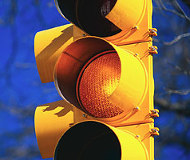Article from: www.thenewspaper.com/news/45/4581.asp
12/2/2014
Ohio: Longer Yellows Cut Violations in Columbus, Springfield
Ohio law mandates an extra second of yellow time, violations plunge by more than half in Columbus and Springfield.
 An extra second of yellow time is costing Ohio municipalities millions of dollars in annual revenue. The General Assembly in 2008 enacted a law requiring all cities using red light cameras to lengthen the duration of the warning given to motorists approaching a photo enforced intersection. Cities were given until March 12, 2009 to make the change, and the cities that complied saw a dramatic reduction in violations.
An extra second of yellow time is costing Ohio municipalities millions of dollars in annual revenue. The General Assembly in 2008 enacted a law requiring all cities using red light cameras to lengthen the duration of the warning given to motorists approaching a photo enforced intersection. Cities were given until March 12, 2009 to make the change, and the cities that complied saw a dramatic reduction in violations.
In Springfield, cameras have issued automated tickets at ten intersections since 2006. Before the yellow timing law took effect, the city's for-profit vendor issued an average of 18,185 citations annually. Between 2009 and 2013, warning times increased to between 4.6 and 5.0 seconds at the intersections with cameras, and the average number of tickets issued dropped 63 percent to 6707 citations annually. This plunge represents a net loss of $4.9 million in revenue.
Contrary to the assertions of the photo ticketing industry, the effect of the lengthened yellows did not diminish over time. Last year, the 6091 tickets were issued, a 67 percent drop from the number of tickets issued in the shortened yellow period of 2008.
In Columbus, the number of tickets issued with shortened yellows dropped from 38,182 in 2008 to 17,018 in the lengthened yellow period of 2010 -- a 55 percent reduction.
Most Columbus intersections saw their yellow times increase from 3.6 seconds to 4.6 seconds, in compliance with the law. Longer term analysis of the change is more difficult because Columbus dealt with the loss of revenue by, in 2012, doubling the number of cameras used.
Not all cities have followed the law. As TheNewspaper reported in October, the city of Dayton has is issuing tickets at intersections where the yellow time was not increased, as required.
Each fraction of a second difference in yellow time can have a significant influence on the number of red light camera citations issued. The majority of straight-through red light "violations" happen when a driver misjudges the end of the yellow light by less than 0.25 seconds -- literally the blink of an eye (view Texas Transportation Institute (TTI) chart). In most cases, a yellow shortened by one second can increase the number of tickets issued by 110 percent, according to TTI (view report).
 An extra second of yellow time is costing Ohio municipalities millions of dollars in annual revenue. The General Assembly in 2008 enacted a law requiring all cities using red light cameras to lengthen the duration of the warning given to motorists approaching a photo enforced intersection. Cities were given until March 12, 2009 to make the change, and the cities that complied saw a dramatic reduction in violations.
An extra second of yellow time is costing Ohio municipalities millions of dollars in annual revenue. The General Assembly in 2008 enacted a law requiring all cities using red light cameras to lengthen the duration of the warning given to motorists approaching a photo enforced intersection. Cities were given until March 12, 2009 to make the change, and the cities that complied saw a dramatic reduction in violations.